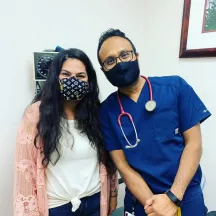Glossary
Jump to...
Filter by
A
- abdominoperineal resection (APR)
(ab-dom-in-oh-pare-IN-ee-al) Surgical procedure in which some of the organs of the abdomen and pelvis are removed to prevent further spreading of the cancer; sometimes performed for rectal cancer.
- ablation
In medicine, the removal or destruction of a body part or tissue or its function.Ablation may be performed by surgery, hormones, drugs, radiofrequency, heat, or other methods.
- abscess
An enclosed collection of pus in tissues, organs, or confined spaces in the body. An abscess is a sign of an infection.
- adenocarcinoma (ah-DEE-no-car-sin-NO-ma)
Cancer that begins in the cells that line certain internal organs and that have glandular properties and secrete mucus; 90% of all colorectal cancers are adenocarcinoma.
- adenoma
A usually benign (non-cancerous) tumor of glandular tissue that should be treated as precancerous.
- adhesion
Scar tissue that binds connecting surfaces to each other inside the body. Sometimes occurs after surgery and may cause complications such as pain, constipation, or an obstruction.
- adjuvant therapy (a-joo-vunt)
Cancer treatment that is given after the primary cancer treatment to lower the risk that the cancer will return. Adjuvant therapy may include chemotherapy, radiation therapy, hormone therapy, targeted therapy, or biologic therapy.
- advanced directive
A legal document that states your wishes about health care choices, or names someone else to make those choices if you become unable to do so. An advanced directive can be very general about your care, or it can be very specific, detailing your wishes regarding your acceptance or refusal of certain life-sustaining treatments. The advance directive may also include a statement about organ and tissue donation.
- alopecia (al-o-PEE-schuh)
Loss of hair or baldness, sometimes caused by certain cancer treatments; hair will usually grow back after treatment has finished.
- alternative medicine
Treatments used in place of standard mainstream treatments, which are more widely used and are based on the results of scientific research. Less research has been done for most alternative medicine. Alternative medicine may include special diets, vitamins, herbs, teas, and magnet therapy.
- anal cancer
Cancer that forms in the cells of the anus. The anus is a short tube at the end of your rectum (the last part of the large intestine) where stool leaves your body.
- anastomosis (ah-nass-ta-MOH-sis)
Surgically connecting two ends of bowel after a diseased segment is removed (resection).
- anemia
A condition in which there is a decrease in the number of red blood cells; may occur with chemotherapy or after surgery. Symptoms may include shortness of breath, dizziness, pale skin, feeling faint or lightheaded, heart palpitations, or fatigue.
- angiogenesis (an-jee-o-JEN-uh-sis)
Development of new blood vessels that feed a tumor; anti-angiogenesis drugs attempt to block the formation of these blood vessels.
- antibody
A protein component of the immune system that circulates in the blood and fights off diseases.
- anxiety
Feelings of intense fear, dread, and uneasiness that may occur as a reaction to stress. A person with anxiety may sweat, feel restless, and have a rapid heartbeat.
- apoptosis (a-pop-TOE-sis)
Self-destruction of cells; may be used to force cancer cells to die in certain cancer treatments.
B
- BRAT diet
Bananas, rice, applesauce, and toast diet; this combination of foods can sometimes be used to stop or slow down diarrhea.
- barium x-ray
A test to examine the inside of the intestines. X-rays of the abdomen are taken after a patient drinks a liquid containing barium to coat the inner lining of the intestines.
- benign (be-NINE)
Not cancerous. Benign tumors do not spread to tissues around them or to other parts of the body.
- bile duct
The tube through which bile passes in and out of the liver and is stored in the gallbladder.
- biologic medication
A medicine that is made in a living system, such as yeast, bacteria, or animal cells (as opposed to a chemically manufactured medication) to prevent, diagnose, or treat cancer and other diseases.
- biomarker
A biological molecule found in blood, body fluids, or tissues that is a sign of a normal or abnormal process, or of a condition or disease. A biomarker test may be used to see how well the body responds to a treatment for a disease or condition. Also called molecular marker and signature molecule.
- biopsy
The removal of cells or tissues for examination in a laboratory; used to determine whether or not the cells or tissue are cancerous.
- biosimilars
A drug that is very similar to another biological drug that has already been approved for use by the FDA. A biosimilar drug acts in the same way and has the same benefit as the biological drug.
C
- CAT scan
A series of detailed pictures of areas inside the body, taken from different angles; the pictures are created by a computer linked to an x-ray machine. Also called computed tomography (CT scan), computerized axial tomography, or computerized tomography.
- Crohn’s disease
A chronic disease that causes inflammation of the gastrointestinal tract. It primarily affects the lower intestine but can affect any part of the large or small intestine, stomach, or esophagus. It is a type of inflammatory bowel disease (IBD). Symptoms include fever, diarrhea, stomach cramps, and weight loss. Having Crohn’s disease increases the risk of colorectal cancer.
- cachexia (ka-KEK-see-uh)
Weight loss and muscle wasting that may occur during the course of a chronic illness such as cancer.
- carcinoembryonic antigen (CEA) (car-sin-o-em-bre-ON-ic AN-tuh-jin)
A protein marker in the blood that may be present with some cancers and other diseases; may be used in some cases of colorectal cancer to monitor response to treatment or disease recurrence.
- cecum (SEEK-um)
The first part of the large intestines, located on the right side of the abdomen. The appendix is attached to the cecum.
- cell
The smallest unit that makes up all living organisms. Humans are made up of billions and billions of cells.
- chemoembolization (key-mo-em-bo-li-ZAY-shun)
A procedure in which the blood supply to a tumor is blocked surgically or mechanically, and anticancer agents are administered directly into the tumor.
- chemotherapy
Treatment that uses certain medications to stop the growth of cancer cells. Chemotherapy may be given as pills, injections, infusion, or topically on the skin, depending on the type and stage of the cancer being treated.
- chronic
A disease or condition that lasts for three months or longer; it also may get worse over time. Chronic diseases can usually be controlled but not cured.
- colon
The part of the large intestine that extends from the end of the small intestine (cecum) to the rectum.
- colonoscope
Flexible, elongated tube that can be inserted through the anus and passed through the colon allowing visualization of the inside.
- colonoscopy
Visual examination of the inner surface of the colon and rectum by means of a colonoscope.
- colostomy
A surgical procedure that creates an artificial opening of the colon through the skin of the abdomen to allow for the passage of stool; also, the opening itself.
- complementary therapy
Treatment that is used along with standard treatment. Complementary therapy examples are nutrition, acupuncture, vitamins, massage, and meditation. Also called complementary medicine.
D
- dehydration
A condition caused by the loss of too much fluid from the body; it can occur when a person is losing more fluids than they are taking in.
- depression
A mental condition with symptoms such as feelings of sadness, hopelessness, loss of pleasure in activities, lack of energy, change in sleeping or eating habits, difficulty completing daily tasks, and thoughts of death or suicide. Depression can affect anyone and can be successfully treated.
- differentiated
Refers to how specialized a cell is to perform a specific function; in cancer, the more specialized or differentiated the cancer cell is, the closer to normal it is.
- digital rectal examination (DRE)
An exam in which the doctor inserts a lubricated, gloved finger into the rectum to feel for anything abnormal. This simple, painless test can detect many rectal cancers and some prostate cancers.
E
- EGFR (Epidermal Growth Factor Receptor)
A protein on the surface of some tumor cells, which may increase the growth and spread of cancer.
- electrolytes
The minerals in the blood and other body fluids which carry an electric charge. Electrolytes affect how the body functions in many ways, such as balancing the amount of water in the body, the acidity of the blood (pH), muscle function, heart rhythm, and other important processes. Examples of electrolytes are potassium, sodium, calcium, magnesium, chloride, and magnesium.
- embolization
A procedure that injects substances directly into an artery to block or reduce the blood flow to a tumor.
- endoscopy (en-DAHS-kuh-pee)
A visual inspection of body organs or cavities using a flexible, lighted tube called an endoscope. This method is referred to by different names, depending on the area of examination. An upper endoscopy (also called an esophagogastroduodenoscopy or EGD)examines the inner lining of the upper digestive tract (the esophagus, stomach, and duodenum, which is the first part of the small intestine). A colonoscopy is also a type of endoscopy; it examines the lining of the colon and rectum.
- enema
The introduction of fluid into the rectum and colon. An enema may be used to clean out the bowel or to inject radiographic substances (such as barium) for certain x-ray tests.
F
- Food and Drug Administration (FDA)
The U.S. federal government agency that protects public health by ensuring that food, ensuring cosmetics, and nutritional supplements are safe to use and truthfully labeled. The FDA also ensures that drugs, medical devices, and equipment are safe and effective, and that blood for transfusions and transplant tissue are safe.
- familial adenomatous polyposis (FAP) (fuh-MIH-lee-al a-dh-NOH-mah-tuss PAH-lee-POH-sis)
An inherited disorder in which hundreds to thousands of pre-cancerous polyps form on the inner walls of the colon and rectum. People with FAP have a very high risk of developing colorectal cancer at an early age and are also at risk of developing cancers in other organs. FAP is due to mutations in the APC gene.
- fecal immunochemical test (FIT)
An at-home screening test that looks for hidden blood in the stool, which can be an early sign of colorectal cancer. FIT does not require dietary restrictions.
- fellow
A doctor who has completed their residency (general training), but is specializing in a field such as medical oncology or radiation oncology. A fellow is under the supervision of a senior physician.
G
- gFOBT (Guaiac-based Fecal Occult Blood Test)
An at-home screening test that looks for hidden blood in the stool, which can be an early sign of colorectal cancer. A gFOBT test requires you to avoid certain foods for a period before the test.
- general anesthesia
A temporary loss of feeling and a complete loss of awareness that feels like a very deep sleep. It is caused by special drugs or other substances called anesthetics. General anesthesia keeps patients from feeling pain during surgery or other procedures.
- genetic mutation
An abnormality in the structure of a gene. A mutation may be hereditary (something a person is born with) or acquired (a change that develops on its own).
- genetic testing
Blood or tissue tests that may be ordered to detect the presence of genetic abnormalities that place a person at risk for getting certain diseases, such as cancer. For patients and families suspected of having an inherited disease it may be possible to find the mutation causing the disease through genetic testing of blood.
- gluten
A protein found in foods that contain wheat, rye, barley, and other whole grains. It is also found in other products such as medicines, vitamins, and supplements.
H
- hepatic arterial infusion (HAI)
The delivery of chemotherapy agents to the liver through a catheter placed in the hepatic artery. Usually performed in an operating room under general anesthesia.
- histologic grade
A description of a tumor based on how abnormal the cancer cells look under a microscope and how quickly the cancer cells are likely to spread. Low-grade cancer cells look more like normal cells and tend to grow and spread more slowly than high-grade cancer cells. Sometimes called tumor grade.
I
- Institutional Review Board (IRB)
Under FDA regulations, an Institutional Review Board is a group that has been formally designated to review and monitor biomedical research involving human subjects. An IRB has the authority to approve, require modifications in, or disapprove research. The board also reviews the consent information to make sure that it is written in clear, understandable language.
- ileostomy (ill-ee-OSS-tuh-me)
A surgical procedure that creates an artificial opening of the small intestine (ileum) through the skin to allow for passage of stool; also, the opening itself.
- immune system
The network of cells, tissues, organs, and the substances they make which help the body fight infections and other diseases.
- immunotherapy
Immunotherapy is a type of treatment that uses a person's own immune system to fight cancer. Immunotherapy can boost or change how the immune system works so it can locate and destroy cancer cells.
- inflammatory bowel disease (IBD)
A group of diseases that cause inflammation of the bowel. Crohn’s disease and ulcerative colitis are both forms of IBD.
- informed consent
The process in which patients are given important information, including possible risks and benefits, about a medical procedure, treatment, genetic testing, or a clinical trial. Also called the consent process.
- infusion
A method of putting fluids or medication (such as chemotherapy) into the bloodstream. Also called intravenous infusion. May be given over several hours or days.
- intern
A doctor in their first year of training after graduating from medical school; an intern is under the supervision of other doctors.
- internal radiation
A type of treatment in which a source of radiation is put inside the body. The radiation source may be solid or liquid. Internal radiation therapy with a solid source is called brachytherapy. Internal radiation therapy with a liquid source is called systemic therapy.
L
- Lynch Syndrome
An inherited disorder in which affected individuals have a higher-than-average risk of developing colorectal cancer and certain other types of cancer, often before the age of 50. Also called hereditary nonpolyposis colon cancer and HNPCC.
- laparoscopic surgery
Surgery that is done with a laparoscope, which is a thin, flexible tube with a very small camera on the end. The laparoscope is inserted into the abdominal wall through a small incision. A second or third incision may also be made in other areas of the abdomen to insert other instruments. Also called minimally invasive surgery.
- lesion (lee-zhun)
An area of abnormal body tissue; sometimes used as another word for tumor. May also be used to describe a change in the appearance or texture of skin, such as an open sore, scab, or discolored area.
- liver directed therapy
Treatments that use chemotherapy, ablation, radiation, cryotherapy, heat, or other approaches to reduce or remove colorectal cancer that has spread to the liver.
- local anesthesia
A temporary loss of feeling in one small area of the body caused by special medications called anesthetics. The patient stays awake but has no feeling in the area of the body that is treated with the anesthetic.
- local excision
A procedure that removes a diseased part by surgical means; local excision is the removal of the diseased tissue close to the affected organ.
- low anterior resection (LAR)
A surgery during which the lower part of the large intestine, including the rectum, is removed.
- lymph nodes
Lymph nodes are small bean-like structures that contain immune cells. They act as filters for foreign substances, such as cancer cells and infections. There are hundreds of lymph nodes throughout the body; they are located in many parts of the body, including the neck, armpit, chest, abdomen, and groin.
M
- MRI - magnetic resonance imaging
An imaging procedure that uses radio waves, powerful magnets, and a computer to make a series of very detailed pictures of areas inside the body. A contrast dye may be injected into a vein to help the tissues and organs show up more clearly in the picture.
- metastasis (meh-TAS-tah-sis)
The spread of cancer from the part of the body where it started to another part of the body.
- microspheres
Tiny, hollow, round particles used to deliver substances that may kill cancer cells. May also be used to attack tumors by obstructing the blood vessels that lead to them.
N
- National Cancer Institute (NCI)
NCI is a federal agency that oversees the nation’s cancer research programs. Many clinical trials are funded by and/or conducted with NCI.
- nasogastric tube (NG)
A small, flexible tube that is passed through the nose and down through the esophagus into the stomach. It can be used to remove the contents of the stomach, including air, or to decompress the stomach.
P
- PET scan
A positron emission tomography scan (PET) is an imaging procedure in which a scanner is used to make detailed, computerized pictures of areas inside the body where glucose (sugar) is taken up. Because cancer cells often take up more glucose than normal cells, the pictures can be used to find cancer cells in the body.
- palliative care
Specialized care that is meant to improve the quality of life of patients who have serious illnesses, such as cancer. Anyone can receive palliative care regardless of the stage of disease.
- palliative care
Specialized care that is meant to improve the quality of life of patients who have serious illnesses, such as cancer. Anyone can receive palliative care regardless of the stage of disease.
- partial response
A result of cancer treatment that did not rid the body of the cancer completely but did result in either stopping or shrinking the cancer.
- pathologist
A doctor who examines and identifies cells and tissues that have been removed from the body.
- pelvic exenteration
Surgical removal of all of the organs of the pelvis; performed to treat cancers of the rectum or other pelvic organs.
- pelvis
The area of the body below the abdomen that contains the hip bones, bladder, and rectum. Inwomen, it also contains the vagina, cervix, uterus, fallopian tubes, and ovaries. In men, it also contains the prostate and seminal vesicles.
- phases (clinical trials)
Specific points in clinical trials. Clinical trials for anti-cancer drugs are conducted in three phases. The phase of the trial is not necessarily related to the stage of the cancer being studied.
- placebo
An inactive substance that looks the same as, and is given the same way as, an active drug or treatment that is being tested in a clinical research trial.
- polyp (pah-lupp)
A growth from a mucous membrane commonly found in organs such as the rectum, the uterus, and the nose. Certain types of polyps, such as adenomas, may develop into cancer. Colorectal screening is important to detect polyps and early cancer.
R
- radiation frequency ablation (RFA)
A procedure that uses radio waves to heat and destroy abnormal cells. A CT scan or ultrasound is used to guide a tiny probe into the tumor. Often used to treat colorectal cancer that has spread to the liver.
- radiation simulation
The process before radiation therapy in which the radiation oncologist and therapists measure the patient and decide how to direct the radiation beams.
- radiation therapy
A form of cancer treatment that uses high-energy waves, such as x-rays, gamma rays, electron beams, or protons, to destroy or shrink tumors.
S
- sedation
The use of medications to help a patient relax and not feel pain or discomfort during a medical procedure; usually used for short procedures such as colonoscopies.
- sexual dysfunction
Abnormal functioning of the sexual organs, or difficulty engaging in sexual activity.
- sigmoidoscopy
An examination with a thin, tube-like instrument (sigmoidoscope) of the inside of the sigmoid colon, which is the part of the large intestine that empties into the rectum.
- stoma
A surgically created opening from the inside of the body to the outside. Also called an ostomy.
- stomatitis (sto-ma-TIE-tuss)
Painful inflammation and redness of the inside of the mouth; sores, ulcers, or tiny cuts and cracks may be present.
- stool DNA test (sDNA)
An at-home screening test that looks for certain abnormal sections of DNA from cancer or polyp cells as well as blood in the stool, which can be a sign of colorectal cancer.
T
- TACE
Trans-arterial chemoembolization is a procedure that injects substances directly into an artery in the liver to block or reduce the blood flow to a tumor in the liver. See also embolization.
- TNM (Tumor Node Metastasis)
A widely used cancer staging system that classifies the extent of the tumor size (T), number of cancerous lymph nodes involved (N), and whether the cancer has metastasized (M).
- targeted therapy
A type of treatment that uses medication or other substances to identify and attack cancer cells and spares harm to normal cells.
- total parenteral nutrition (TPN)
A method of providing nutrition that bypasses the gastrointestinal tract. A special formula given through a vein supplies most of the nutrients the body needs. TPN is used when someone can't or shouldn't receive feedings or fluids by mouth.
U
- ulcerative colitis (UC)
A chronic disease that causes inflammation and ulcers in the lining of the large intestine. It primarily affects the lower intestine and rectum but may affect the entire colon. UC rarely affects the small intestine except for the lower section (the ileum). It is a type of inflammatory bowel disease (IBD). Having UC increases the risk of colorectal cancer.
Y
- Y-90 (Yttrium-90)
A procedure that combines embolization and radiation therapy to treat tumors in the liver. Tiny beads filled with radioactive material are placed inside the blood vessels that feed a tumor. This blocks the supply of blood to the cancer cells and delivers a high dose of radiation to the tumor while sparing normal tissue.





